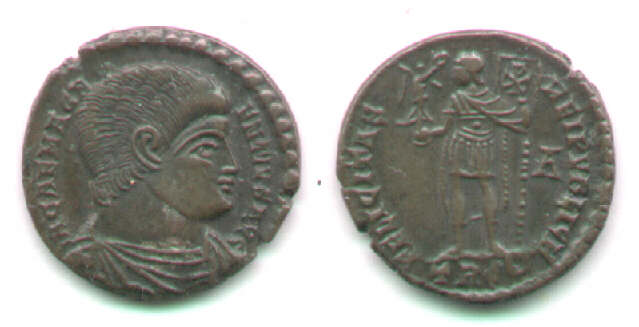 FELICITAS REIPVBLICE
FELICITAS REIPVBLICEMagnentius and Decentius (350-353). Ancient imitations.
Imitations of AE of Magnentius and Decentius are almost as common as "official" issues. Some are crude and smaller than official issues, but many are nearly full size and of passable style. The line between the official coins and the imitations is often fine.
Pierre Bastien wrote a huge book, La Monnayage de Magnence (second edition, 1983), on the coins of Magnentius. It illustates very many examples of each type, including many imitations. (Be sure to consult the second edition. It has many supplemental plates of coins not in the first edition.)
For a survey of late Roman imitations including a couple of these types, see Bastien, "Imitations of Roman bronze coins" in ANSMN 30 (1985), 143-174 and plates 41-44.
Imitations are of several types, apparently numerous in proportion to the numbers of the originals. The common types of Magnentius are commonly imitated, and I imagine the primary reason I have not seen imiations of some of his rare originals is they are proportionally rare. Imitations of the early types are of full size or nearly full size. The "two victories" imitations begin of full size, but continue on down to tiny -- as tiny as the small FEL-TEMP-REPARATIO-soldier-spearing-fallen-horseman imitations so common in England.
Here are prototypes of the types commonly copied. (Skip down to the imitations.)
 FELICITAS REIPVBLICE
FELICITAS REIPVBLICE
This example: AE22, RIC Trier 266, page 158, very common. 19 Jan. 350 - Spring 351.
IM CAE MAGN-ENTIVS AVG
/emperor standing left holding Victory and labarum.
Other examples may have a rosette diadem. This issue was before the elevation of Decentius (Spring 351)
Its imitations (below).
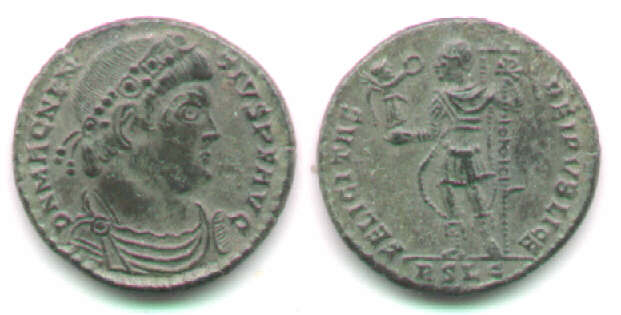 another FELICITAS REIPVBLICE
another FELICITAS REIPVBLICE
This example is from Lugdunum (Lyons). AE22. 6:00. 5.54 grams. RIC Lyons 112.
Note the fine style, albeit a large eye. The Trier type is bare-headed. This one from Lyon has a rosette diadem.
Its imitations are below.
 GLORIA ROMANORVM
GLORIA ROMANORVM
This example: AE23, RIC Trier 270, common, page 158.
DN MAGNEN-TIVS PF AVG
/emperor kneeling right, spearing kneeling enemy
This issue was after FELICITAS REIPVBLICE, but also after before the elevation of Decentius (Spring 351).
Its imitations are below.
This example: AE20, RIC Arles 184, page 217.
DN MAGNEN-TIVS PF AVG
/two victories standing facing each other, holding shield between them, inscribed
VOT/V/MVL/X
This type sometimes comes with a column supporting the shield. The chi-rho above the shield is optional.
This issue was jointly with Decentius.
Its imitations are below.
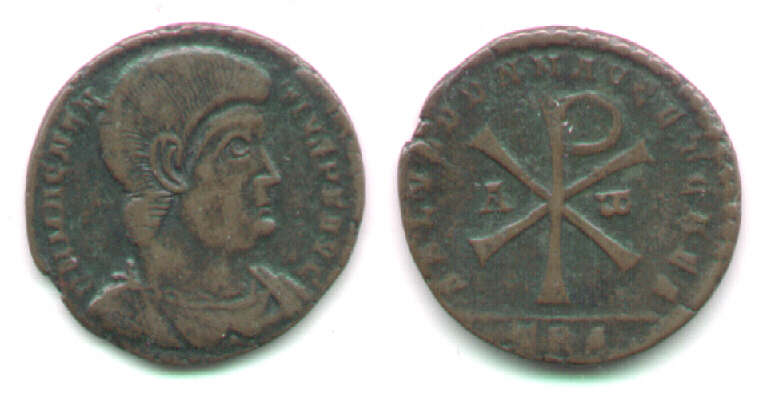 SALVS DD NN AVG ET CAES, with chi-rho
SALVS DD NN AVG ET CAES, with chi-rho
This example: AE27, RIC Trier 318, common.
DN MAGNEN-TIVS PF AVG
/large chi-rho between alpha and omega
This was the last issue.
Its imitations are below.
This is the end of the images of prototypes.
Imitations: FELICITAS REIPVBLICE
The fact that none of the imitations of this type are much smaller than the originals suggests this type was discontinued and imitations began, instead, to be modeled after the "two victories holding shield" type below.
 AE21. 6:00. 4.08 grams.
AE21. 6:00. 4.08 grams.
This excellent coin is one of those that is too close to official to call with certainty.
DN MAGNEN-TIVS PF AVG
/star if field left, A in field right. Cross-rho on standard.
/mintmark mostly off the flan, but possibly the top of an "R" (as in "TRP") in the middle.
No particular element screams "imitation!" But, in combination, the elements do not fit a published official type. The bare-headed bust is only at Trier and the obverse legend is not listed at Trier for this type. See RIC page 157f.
Bastien, 20-30, 148-155, and 230-234 for type and Plate XVI imitations 5-14, supplement 21-31, 149-154, and 229-231. Plate S VII bottom 150, 156-8.
Bold and well-struck, but with letter forms far from official.
DN MAC ...
/lots of letters resemble the correct letters, but many do not.
/mintmark: an attempt at TRP, with the "R" a bit like a reversed "N".
Prototype of Trier.
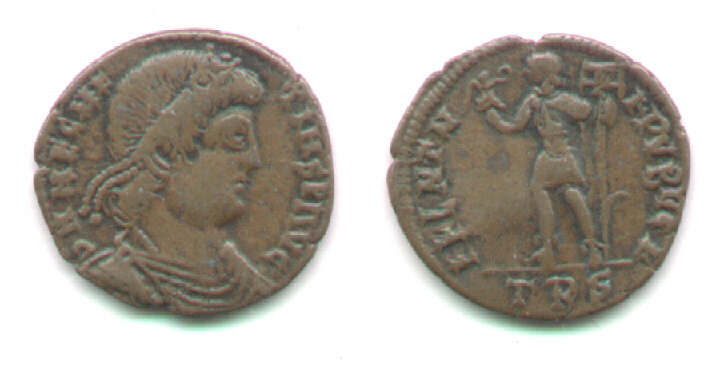 AE24. 6:00. 4.93 grams.
AE24. 6:00. 4.93 grams.
Very large, with an excellent portrait and well-done reverse type. That is almost enough to make one think it is official. However, the lettering is too far from official. Look closely to see how nearly it reproduces these legends:
DN MAGNENTIVS PF AVG
/FELICITAS REIPVBLICE
The mintmark TRS is clear.
The rosette-diadem was not used on official issues at this mint.
This is an outstanding example of an imitation.
Good style. Only slightly "barbarous".
/A in reverse field right.
Mintmark: TRS (clipped)
Prototype: RIC Trier 264 with an obverse legend variant.
A very well done imitation, with passable lettering which is only a bit too extreme.
Prototype: RIC Lyons 112.
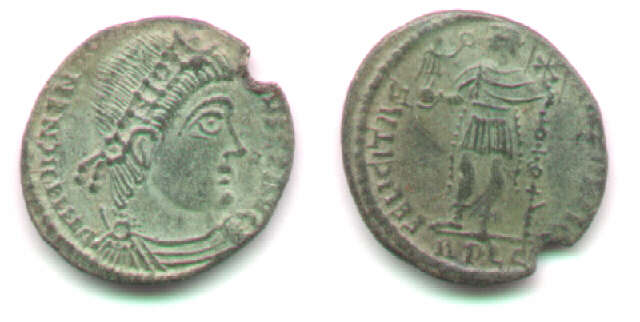 AE22-21. 6:00. 4.45 grams.
AE22-21. 6:00. 4.45 grams.
Beautiful green color. This one is very close to official and might well be, but the ski nose is unlike most high-style coins of the Lyons mint.
mintmark: RPLG
Prototype: RIC Lyons 112.
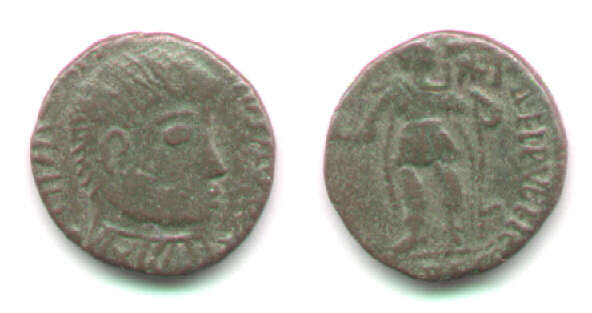 AE20. 5:30. 4.52 grams.
AE20. 5:30. 4.52 grams.
There is no doubt this one is an imitation! A cartoon-like portrait. Slightly, but noticably, smaller than official, but not lighter -- it is thicker than normal.
This piece is cruder than any of the examples in Bastiens's book on Magnentius.
Imititions: GLORIA ROMANORVM
 AE20. 6:00. 3.66 grams.
AE20. 6:00. 3.66 grams.
A few milimeters smaller than the originals.
The "A" behind the head is almost an "H". The portrait style is not far from official. Many letters on the reverse are reasonably well-formed, but the initial "G" of GLORIA is backwards.
The prototype mintmark is RPLC of Lyons, RIC 115, plate 5.115. This is a faithful copy of the types.
From a dealer in Spain.
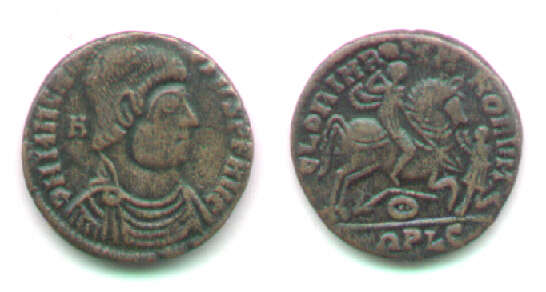 AE18. 6:00. 3.04 grams.
AE18. 6:00. 3.04 grams.
Distinctly smaller than the originals. Very well executed. All the letters of the legend are in their proper postions, but not quite with official letter forms. Mintmark prototype from Lyons, RIC Lyon 117, with a U-like shape followed by PLC, where here the U is upside down. Prototype struck 350-Spring 351 before the elevation of Decentius.
From a dealer in England who said it was from Spain.
Imitations: VICTORIAE DD NN AVG ET CAE
All of these imitations are from English sources.
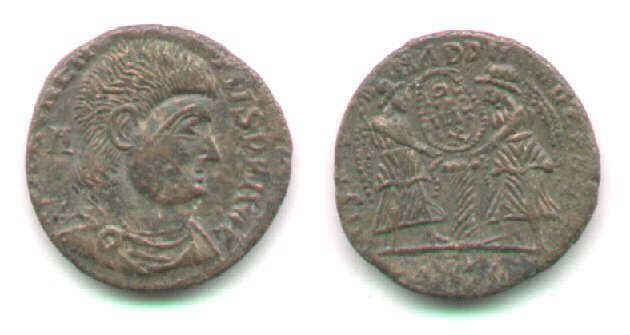 AE21. 6:00
AE21. 6:00
A full-size imitation. The lettering is too uneven, especially on the shield.
/a column supports the shield.
This issue with the supporting column is the first after the elevation of Decentius.
Prototype: RIC Lyons 122, page 186.
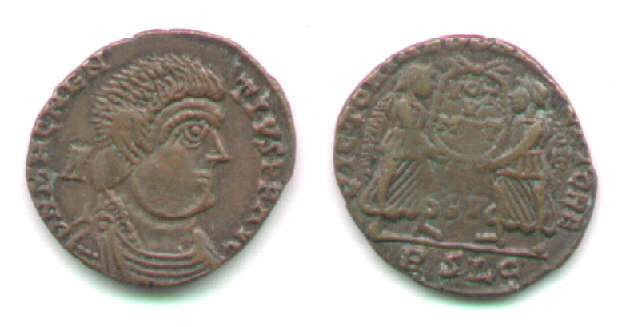 AE21. 6:00. 4.28 grams.
AE21. 6:00. 4.28 grams.
Another full-size imitation in good style -- just a bit too extreme. From the isue following the issue of the previous prototype
/S V below the shield. mintmark RSLG
Prototype: RIC Lyon 126, page 186. Bastien 174. Bastien imitation XVIII.57 is very similar.
A distinctly smaller imitation with heavy patina obscuring some details.
Found in England.
Prototype possibly RIC Trier 312, page 163, struck 352.
Heavy green patina.
Letters and shield inscription are well-formed.
Found in England in the region of Cambridge.
Very crude and small.
On the obverse, the "AVG" is bold.
Shield inscription is nonsense: O/OO/ \
Six more, smaller, imitations. From 16-11 mm.
The numerous imitations of this type in this very small size tell us that this type was imitated longer than the others.
The fourth piece is especially interesting for its good style. It is good enough to call it official, in which case it would have to be a different denomination than the large-size ones. I have seen other tiny imitations of this quality and style, some even better. Such coins have prompted scholars to consider the official existence of the smaller denomination. I, personally, just think it is a very well-done imitation from a slightly later time period when this smaller size was commonly in circulation.
Note the blundered forms of the inscripions of the shield, which range from I's to O's.
These imitations are common, even though they are only a small fraction of the abundant English imitations of this size. They are found mixed in which far larger numbers of small FEL TEMP REPARATIO soldier-spearing-fallen-horseman imitations. The heavy green patination is very common on such coins.
Decentius
VICTORIAE DD NN AVG ET CAE
 AE22. 6:00. 3.51 grams.
AE22. 6:00. 3.51 grams.
Superb imitation.
DN DECENTIVS NOB CAES, bare head, draped and cuirassed, right
letters in very good style, with the "A" more like an "H".
/VICTORIAE DD NN AVG ET CAE
/two Victories holding shield inscribed "VOT/V/MVL/X" on column, S and V to either side of column
/AMB in exergue (Ambianum mint)
References: RIC VIII Ambianum 6, page 122 "S" for type, but Ambianum issues do not have letters in the field, which are only on issues from Lugdunum, e.g. RIC Lugdunum 125-133, Bastien V.169-171, 174-179, and 182-189. Bastien (2nd Ed.) XVII.34 has a die-identical reverse with a Magnentius obverse in the "imitation" section.
Bought from a dealer in France.
A superb imitation of reduced size. Even the lettering is good, but the shield inscription is merely "VOT/MVLT", omitting the V and X.
DN DECENTIVS NOB CAES, bare head, draped and cuirassed, right
/shield supported by a column.
Mintmark: RSLG
See Bastien, XVIII.40 and 42 for imitations of this size.
Imitations: SALVS DD NN AVG ET CAES, with large chi-rho
Although this issue was the last issue of Magnentius, its imitations did not continue in the same way that the imitations of the above "two victories" type did. I attribute this to the large size, which was not compatible with the sizes of the coins of Constantius II.
Most of the imitations of this type are full-size or very nearly so, and in reasonably good style. They deviate from official issues much less than many other types of imitations.
DN MAGNEN-TIVS PF AVG
/SALVS DD NN AVG ET CAES, large chi-rho with alpha to left and omega to right.
This imitation: Weakly stuck obverse. Mintmark unclear from any angle. Note the outlining of the chi-rho.
Another well-executed coin. The serifs are angled just like those of official coins of the Lugdunum (Lyons) mint.
Mintmark: LPLG
This piece could well be official.
 AE25-24. 6:00. 8.43 grams.
AE25-24. 6:00. 8.43 grams.
Another well-executed imitation. The style is a little "off."
Mintmark: LSLG. The alpha is crossed oddly.
The half denomination:
SALVS DD NN AVG ET CAES. A much scarcer half-denomination of the usual AE1 coin of the same type:
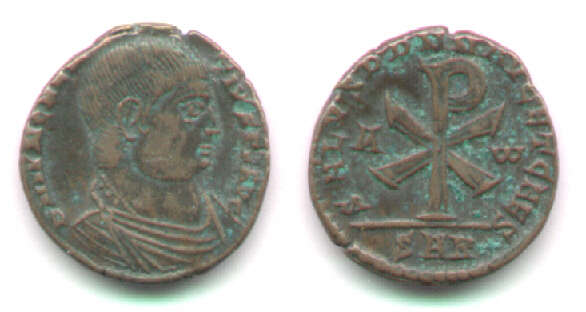

Prototype: AE20, 11:00. Struck Spring 351-353. This example: RIC unlisted, but see page 217, 201
for size and type, and 188 and 194 for this mintmark on the larger type.
Imitation: AE17, 5:00, 2.75 grams. Weakly struck (weakly engraved?) obverse.
Somewhat cruder style. The ear is too high. The hair has little detail. On the reverse the alpha and omega are crude.
Imitations of this type are very rare, probably because the originals are also rare.
FEL TEMP REPARATIO hybrid with a reverse of Constantius II
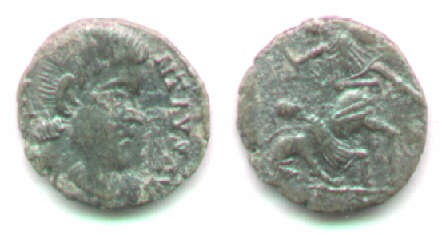 AE15. 7:30. 1.96 grams.
AE15. 7:30. 1.96 grams.
Heavy and glossy dark green patina.
...NTIVS AVG
/soldier spearing fallen horseman reverse of Constantius II
Found near Cambridge, England.
The imitations of Constantius II are extremely numerous. It is very unusual, but not not really surprising, to find one accidentally paired with an obverse of Magnentius.
Continue with the page on Julian's "bull" imitations.
Return to the main Table of Contents page on imitations.